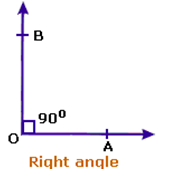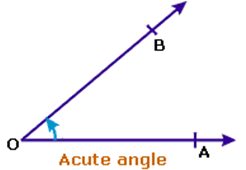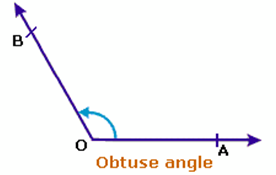Basic Concepts of Geometry Workbook-1
Angles: When two straight lines meet at a point they form an angle. In the figure, the angle is represented as ∠AOB. OA and OB are the arms of ∠AOB. Point O is the vertex of ∠AOB. The amount of turning from one arm (OA) to other (OB) is called the measure of the angle (AOB).

Right angle: An angle whose measure is 90o is called a right angle. ∠ BOA is a right angle in the figure.

Acute angle: An angle whose measure is less then one right angle (i.e., less than 90o), is called an acute angle.

Obtuse angle: An angle whose measure is more than one right angle i. e. 90o and less than two right angles
(i.e., less than 180o and more than 90o) is called an obtuse angle.

Interior angle: An interior angle of a polygon is an angle that is inside the polygon at one of its vertices. So for a polygon with N sides, there are N vertices and N interior angles. For a regular polygon, by definition, all the interior angles are the same. For an irregular polygon, each angle may be different.
Exterior angle: An exterior angle of a polygon is an angle outside the polygon formed by one of its sides and the extension of an adjacent side. If we count one exterior angle at each vertex, the sum of the measures of the exterior angles of a polygon is always 360°.
Polygon : A closed n sided figure where n can be 3,4,5...... Polygon may be regular or irregular. In regular polygon all the sides are same and in irregular polygon all sides may be different.
– A six-sided figure is called a hexagon.
– A seven-sided figure is called a heptagon.
– An eight-sided figure is called an octagon, etc
– These are some 4 sided figures; Rectangle, square, parallelogram,Rhombus
Properties of a Rectangle:
– Opposite sides are parallel.
– Opposite sides are equal
– Each angle is right angle
– Diagonals are equal
– Diagonals bisects each other
Properties of Square:
– All the sides are equal.
– Each angle is of 90°.
– The diagonals are equal.
– The diagonals are perpendicular to each other.
Parallelogram:
– A quadrilateral, which has both pair of opposite parallel sides, is called a parallelogram.
– In a parallelogram, opposite sides are equal.
– The opposite angles of a parallelogram are equal.
– The diagonals of a parallelogram bisect each other.
Rhombus:
– If all sides of a parallelogram are equal, then it is a rhombus.
Click here to view the Full Book